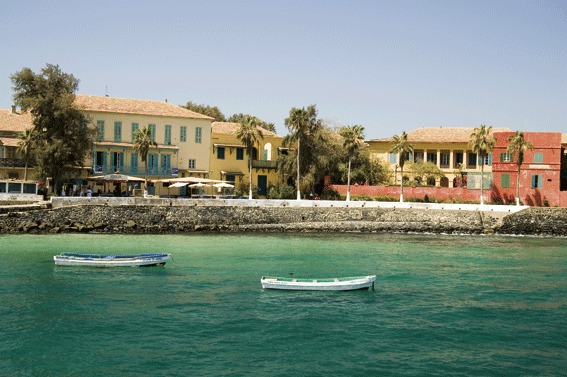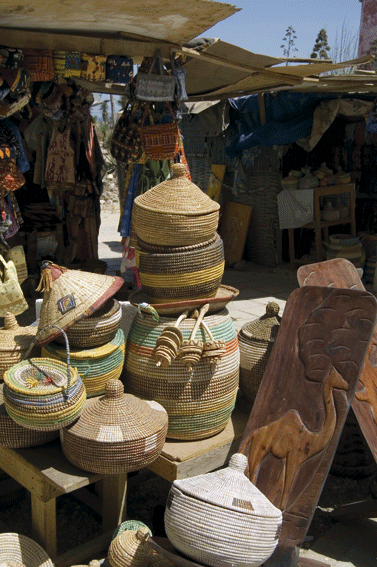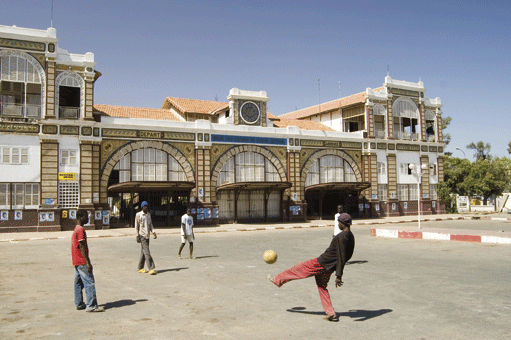
Travel
Senegal
Dynamic Dakar
At the westernmost point of Africa lies Dakar, capital of the Republic of Senegal. A giant of a city in sub-Saharan terms, dynamic Dakar draws migrants from across the Sahel and expatriates from overseas, mainly France and francophone countries beyond.
By: Veronica Maria Garbutt
With a population of over two million inhabitants, the city’s sprawling size and hustle and bustle can at times be overwhelming. But for dramatic setting, breezy climate and sheer style this city is hard to beat.
One of West Africa’s leading seaports, Dakar is a successful blend of old and new. The French influence is ubiquitous in the old Plateau quarter terracotta rooftops, and al fresco restaurants evoke an almost Mediterranean feel. Many mosques dot the cityscape, the most impressive being the Great Mosque with its high minaret and artistically tiled interior. Tall office and apartment blocks line shady tree-lined avenues and stately administrative structures from French colonial days house various government departments today.
The medina quarter is a clear reminder that Dakar is an African city. Here half a million people live cheek-by-jowl in a jumble of tin roof houses, alleys and narrow streets. The huge Marché de Tilene, the size of a football pitch, is crammed with every product imaginable – flowers, vegetables, raw honey from Casamance, cotton prints, mobile phones and bootleg CDs. It is perhaps the best place to people watch and absorb daily life in Dakar.
 From the 10th century CE Senegal had regular trade and intellectual contract with the Islamic world. The first Europeans arrived in the 15th century, merchant adventurers who used La Gorée island as a transit point for slaves destined for the New World. Around 1600 the English and the Dutch entered the scene and fought each other and the French for control over the lucrative trade in ivory, gold and slaves. Dakar, named after the local Wolof Tribal term of dekraw (refuge), was established in 1857 and is the oldest city in West Africa.
At the Berlin conference of 1884-85 when the European countries were dividing up Africa, Senegal was allocated to the French. Towards the end of the 19th century Dakar grew rapidly with the opening of West Africa’s first railway line. Peanut farmers along the route were able to ship their products to Dakar’s port. After much dredging and construction Dakar became a French naval base at the turn of the century and the capital of French West Africa in 1904. During colonial times the city was the first port of call on the coast for ships bound for West and South Africa as well as Latin America.
Independence came in 1960 under the poet-statesman Leopold Sedar Senghor. Since then the port has been expanded to handle fifty ocean going vessels at a time. It comes complete with catering facilities, refrigerated warehouses and pipelines for oil and liquid chemicals. On the economic front groundnut (peanut) growing is the main foreign currency earner. Cotton, millet and sorghum have proved to be successful cash crops and sugarcane, cassava, maize and beans are also grown.
Along the coast vegetables such as squash, okra, eggplants, tomatoes and peppers are cultivated along with tropical fruits including mangoes, coconuts and citrus. Palm oil plants also flourish and the oil is a basic ingredient of local cooking. Wild honey and the fruit and leaf of the baobab tree supplement the Senegalese diet.
Leopold Sedar Senghor airport lies some 14 km from central Dakar and a taxi there will cost you CFA 4,000 (US$7). Place the l’Independence is the hub of the city and home to the Hotel de l’Independence and the Ministry of Foreign Affairs. Ave Leopold Sedar Senghor runs south towards the National Assembly and the IFAN Museum. One of West Africa’s best museums, it showcases tribal masks, traditional dress, agricultural implements, fabrics and musical instruments from all around the region including Mali, Nigeria and Guinea-Bissau.
A few blocks east of Place de l’Independence lies the colourful, bustling Marché Kermal, patterned after Les Halles market in Paris. Not far away lies the elegant white Presidential Palace in lush gardens with guards clad in crimson colonial style uniforms. Other splendid buildings from the same era nearby include the Gouvernance Chamber of Commerce, Hotel de Ville and railway station. Place Soweto is the centre of the Parisian quarter and home to the National Assembly.
West of the city centre lies the beach and fish market of Soumbedione. Here in the late afternoon the pirogues (fishing boats) return. Venture behind the market to see boat builders turning trees into large ocean-going canoes. Back nearer town two corniches – East and West – offer fine cliff top walks. Climb Corniche Est some 4 km to Cap Manuel for picture postcard views of Dakar. And if you fancy some beach time the best ones are Voile d’Or and Monaco, both easily accessible by taxi, on the sheltered Pointe de Bel-Air.
From the 10th century CE Senegal had regular trade and intellectual contract with the Islamic world. The first Europeans arrived in the 15th century, merchant adventurers who used La Gorée island as a transit point for slaves destined for the New World. Around 1600 the English and the Dutch entered the scene and fought each other and the French for control over the lucrative trade in ivory, gold and slaves. Dakar, named after the local Wolof Tribal term of dekraw (refuge), was established in 1857 and is the oldest city in West Africa.
At the Berlin conference of 1884-85 when the European countries were dividing up Africa, Senegal was allocated to the French. Towards the end of the 19th century Dakar grew rapidly with the opening of West Africa’s first railway line. Peanut farmers along the route were able to ship their products to Dakar’s port. After much dredging and construction Dakar became a French naval base at the turn of the century and the capital of French West Africa in 1904. During colonial times the city was the first port of call on the coast for ships bound for West and South Africa as well as Latin America.
Independence came in 1960 under the poet-statesman Leopold Sedar Senghor. Since then the port has been expanded to handle fifty ocean going vessels at a time. It comes complete with catering facilities, refrigerated warehouses and pipelines for oil and liquid chemicals. On the economic front groundnut (peanut) growing is the main foreign currency earner. Cotton, millet and sorghum have proved to be successful cash crops and sugarcane, cassava, maize and beans are also grown.
Along the coast vegetables such as squash, okra, eggplants, tomatoes and peppers are cultivated along with tropical fruits including mangoes, coconuts and citrus. Palm oil plants also flourish and the oil is a basic ingredient of local cooking. Wild honey and the fruit and leaf of the baobab tree supplement the Senegalese diet.
Leopold Sedar Senghor airport lies some 14 km from central Dakar and a taxi there will cost you CFA 4,000 (US$7). Place the l’Independence is the hub of the city and home to the Hotel de l’Independence and the Ministry of Foreign Affairs. Ave Leopold Sedar Senghor runs south towards the National Assembly and the IFAN Museum. One of West Africa’s best museums, it showcases tribal masks, traditional dress, agricultural implements, fabrics and musical instruments from all around the region including Mali, Nigeria and Guinea-Bissau.
A few blocks east of Place de l’Independence lies the colourful, bustling Marché Kermal, patterned after Les Halles market in Paris. Not far away lies the elegant white Presidential Palace in lush gardens with guards clad in crimson colonial style uniforms. Other splendid buildings from the same era nearby include the Gouvernance Chamber of Commerce, Hotel de Ville and railway station. Place Soweto is the centre of the Parisian quarter and home to the National Assembly.
West of the city centre lies the beach and fish market of Soumbedione. Here in the late afternoon the pirogues (fishing boats) return. Venture behind the market to see boat builders turning trees into large ocean-going canoes. Back nearer town two corniches – East and West – offer fine cliff top walks. Climb Corniche Est some 4 km to Cap Manuel for picture postcard views of Dakar. And if you fancy some beach time the best ones are Voile d’Or and Monaco, both easily accessible by taxi, on the sheltered Pointe de Bel-Air.
 On the arts and cultural front music and dance are the main forms of artistic expression in Dakar and Senegal. In the past local dances were adapted to the Islamic culture. Indeed until Muslim traders brought Arabic writing, there was no written language. The best known storytellers are the griots, who not only entertain, but play an important role in recording historical events as well as educating children in Senegalese traditions. Dakar’s best known musician is Youssou N’Dour who shot to stardom with his mbalax style – a mixture of wolof drum rhythms and Western rock. He and his band, Le Super Etoile, still play regularly at his Thiosanne nightclub in Dakar.
Dining out in Dakar is a pleasure, in part thanks to the French influence. A favourite dish is fish stew made with fresh and dried fish plus sea snails and peppers. Along the coast vegetables such as okra, eggplants and tomatoes are grown along with tropical fruit including mangoes, coconuts and pineapples. At Marché Sandaga you can sample the basic Senegalese breakfast of chagry (fermented milk with millet grains and sugar) or millet porridge. Also popular are chicken yassa (with lemon and onion sauce) and maté, a peanut stew with orange palm oil and rice.
Several seafood eateries dot the coastline and then there are Cape Verdean, Vietnamese, Lebanese, India, Mexican, Thai, Korean and Italian restaurants to choose from. For Senegalese cuisine Keur N’Deye comes highly recommended and most evenings there is a griot playing the kora (a 21-string harp-lute). Chez Yanna and Restaurant Le Sarraut serve fine French food while Chez Loutcha is the place to sample Cape Verdean and Euro-Africaine dishes. Le Plaza features classic Italian pasta and seafood while Le Hanoi does good Vietnamese. For India try Jaipur and Le Mex for – you’ve guessed – spicy tacos, burritos, enchilada and more.
Shopping in Dakar can be daunting with markets bursting with over-zealous salesmen. Go in a patient mood and look for the best buys of silver jewellery and wooden chests in Cour des Orfevres. This former Mauritanian silversmiths’ yard, can be found at 69 Ave Blaise Daigne. For good quality local art check out Rue Mohammed V where several shops make and display carvings and masks. Finally, be sure to check out Soumbedioune’s Village Artisanal for a wide array of metalwork, leathergoods, carpets, pottery and gold jewellery.
If you have a day or more to spare don’t miss the chaloupe boat ride to the tiny island of La Gorée. Just twenty minutes away from the capital Gorée is a charming retreat of Mediterranean style flaking pastel houses draped with bougainvillea – and not a car in sight. The island’s slave trading history has helped to win it UNESCO World Heritage Site status. Here you can visit the Maision des Esclaves, Musée de la Femme Senegalaise and Musée de la Mer before winding up at Hostellerie du Chavelièrs for a luscious lobster lunch overlooking the Atlantic. Bon appétit!
On the arts and cultural front music and dance are the main forms of artistic expression in Dakar and Senegal. In the past local dances were adapted to the Islamic culture. Indeed until Muslim traders brought Arabic writing, there was no written language. The best known storytellers are the griots, who not only entertain, but play an important role in recording historical events as well as educating children in Senegalese traditions. Dakar’s best known musician is Youssou N’Dour who shot to stardom with his mbalax style – a mixture of wolof drum rhythms and Western rock. He and his band, Le Super Etoile, still play regularly at his Thiosanne nightclub in Dakar.
Dining out in Dakar is a pleasure, in part thanks to the French influence. A favourite dish is fish stew made with fresh and dried fish plus sea snails and peppers. Along the coast vegetables such as okra, eggplants and tomatoes are grown along with tropical fruit including mangoes, coconuts and pineapples. At Marché Sandaga you can sample the basic Senegalese breakfast of chagry (fermented milk with millet grains and sugar) or millet porridge. Also popular are chicken yassa (with lemon and onion sauce) and maté, a peanut stew with orange palm oil and rice.
Several seafood eateries dot the coastline and then there are Cape Verdean, Vietnamese, Lebanese, India, Mexican, Thai, Korean and Italian restaurants to choose from. For Senegalese cuisine Keur N’Deye comes highly recommended and most evenings there is a griot playing the kora (a 21-string harp-lute). Chez Yanna and Restaurant Le Sarraut serve fine French food while Chez Loutcha is the place to sample Cape Verdean and Euro-Africaine dishes. Le Plaza features classic Italian pasta and seafood while Le Hanoi does good Vietnamese. For India try Jaipur and Le Mex for – you’ve guessed – spicy tacos, burritos, enchilada and more.
Shopping in Dakar can be daunting with markets bursting with over-zealous salesmen. Go in a patient mood and look for the best buys of silver jewellery and wooden chests in Cour des Orfevres. This former Mauritanian silversmiths’ yard, can be found at 69 Ave Blaise Daigne. For good quality local art check out Rue Mohammed V where several shops make and display carvings and masks. Finally, be sure to check out Soumbedioune’s Village Artisanal for a wide array of metalwork, leathergoods, carpets, pottery and gold jewellery.
If you have a day or more to spare don’t miss the chaloupe boat ride to the tiny island of La Gorée. Just twenty minutes away from the capital Gorée is a charming retreat of Mediterranean style flaking pastel houses draped with bougainvillea – and not a car in sight. The island’s slave trading history has helped to win it UNESCO World Heritage Site status. Here you can visit the Maision des Esclaves, Musée de la Femme Senegalaise and Musée de la Mer before winding up at Hostellerie du Chavelièrs for a luscious lobster lunch overlooking the Atlantic. Bon appétit!